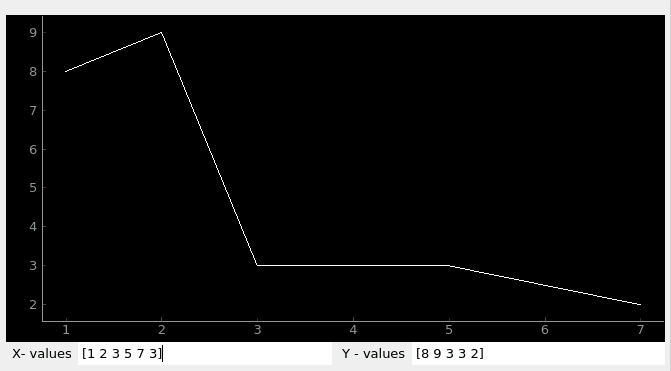Local Plugin
PyDM uses Data Plugins as sources of information to be displayed at the widgets. Local Data Plugin allows users to create and use local variables.
The Local Data Plugin stores the data that is sent by the widgets through a channel, and broadcasts it to all the listeners connected to this particular local variable channel.
By default, as soon as any widgets gets connected to the same channel variable, they will get the initial values that were defined in the channel’s address. These widgets can receive any updates when the data changes, or they can send data back. For example, if the user has added a Local Variable channel to a PyDMEditLine, then all the widgets connected to this Local Variable will get the values that are updated by the user in the PyDMEditLine.
General Local Plugin channel syntax:
loc://my_variable_name?type=variable_type&init=initial_values
Note
Once a Local Variable channel is created, multiple widgets can be connected to the same channel by providing the name of the variable, like so:
loc://my_variable_name
Required Attributes
In order to be able to properly create a Local Variable channel, all the required attributes must be provided in the channel’s address.
The table below explains the attributes that are required to create a local plugin channel:
Attributes |
Description |
Format Example |
|---|---|---|
loc |
protocol name for Local Data Plugin |
loc:// |
name |
the identifier for a local variable
user’s choice
|
my_ndarray_var |
type |
type=array |
|
init |
initial values to be used |
init=[1,2,3,4] |
Here is a simple example of a channel address format with the required attributes:
loc://my_np.array?type=array&init=[1,2,3,4]
Note
Please reference Variable Types section for more information about local variables types.
Extra Attributes
Along with the required attributes, the Local Data Plugin can also accept some optional attributes to configure the Local Variables with. The optional attributes are described in the extra attributes table below:
The table below explains the optional attributes that can go in the extras:
Attributes |
Description |
Type |
Format Example |
|---|---|---|---|
precision |
precision of float values |
int |
precision=3 |
unit |
units for the data |
string |
unit=V |
upper_limit |
upper control value limit |
float or int |
upper_limit=100 |
lower_limit |
lower control value limit |
float or int |
lower_limit=-100 |
enum_string |
new list of values |
tuple |
enum_string=[‘hey’, ‘hello’] |
Note
All the additional attributes are optional, any number of desired attributes can be specified, or none.
Here is a simple example of a channel address format with some optional attributes:
loc://my.float?type=float&init=1&precision=3&unit=V
Variable Types
Local Data Plugin supports the following types:
int
float
bool
str
array - this will be treated as a numpy.ndarray type
Arrays
Note
Arrays will be constructed using numpy.array built in function. See numpy.array for more information on how to construct an array.
The following option must be specified in the “type” value in the channel address:
type=array
The following extra attributes can be specified. These attributes will be passed in the numpy.array function as parameters when creating the numpy.ndarray. If no attributes are specified, the numpy.array function will use the default values to create a numpy.ndarray.
Extra Attributes for numpy.array:
Attributes |
Description |
Type |
Format Example |
|---|---|---|---|
dtype |
desired data-type for the array |
np.dtype |
dtype=float64
dtype=uint8
|
copy |
if True then the object is copied |
bool |
copy=true (default) |
order |
memory layout of the array |
string |
order=K (default)
others {‘A’, ‘C’, ‘F’}
|
subok |
if True then sub-classes
will be passed-through
|
bool |
subok=false (default) |
ndmin |
minimum number of dimensions |
int |
ndmin=0 (default) |
Here is a simple example with array + extras:
loc://my_ndarray?type=array&init=[1,2,3,2]&dtype=float64©=False&order=C&ndmin=0&subok=true
Simple Local Data Plugin Example
The picture below represents a simple example using the Local Data Plugin, where a Waveform Curve Editor has two local data plugin channels:
loc://y?type=array&init=[1,2,3,4,5,6]&dtype=float64
loc://x?type=array&init=[1,2,3,4,5,6]&dtype=float64
Right below the Waveform Curve Editor widget, there are two other widgets connected to the ‘x’ and ‘y’ local variable respectively:
X-values: loc://x
Y-values: loc://y
Data can be updated in the two X and Y-values widgets and the Waveform Curve Editor will receive the new data and change the curve accordingly, like seen in the picture below:
Waveform Curve Example with ndarrays for X and Y values

Miscellaneous
If precision is not set through the “extras”, and it is set to receive the precision from the PV (Process Variable), the Local Data Plugin will match the precision from the values inserted by the users in the widgets.